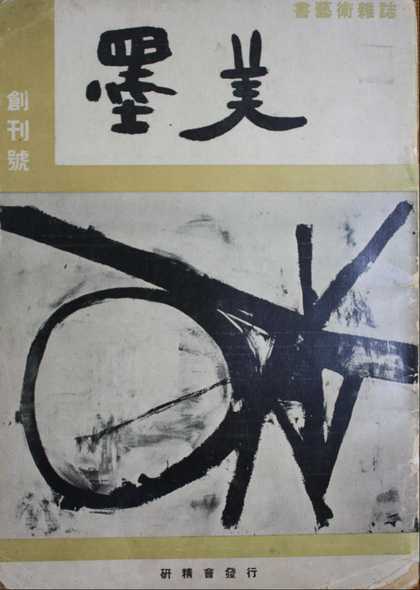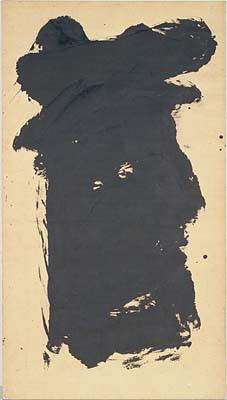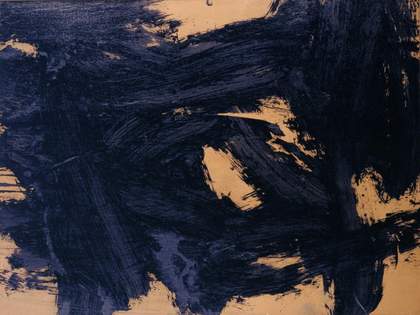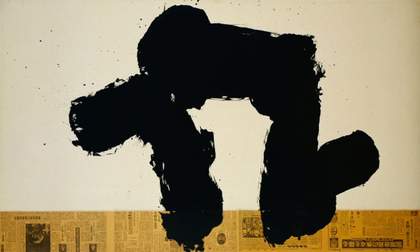Franz Kline’s relationship with East Asian calligraphy is one of the most contested aspects of the interpretation of his oeuvre, with critics making comparisons between his work and Chinese or Japanese calligraphy throughout his career.1 However, although pointing out the visual similarity between Kline’s black and white abstract paintings and East Asian calligraphy became an established mode for addressing his art, the later reassessment of this relationship by Kline and the calligraphers turned out to be a highly politicised venture.
Kline’s Meryon 1960–1 (Tate T00926), a large painting consisting of dynamic black and white strokes, presented Kline’s return to an earlier stage in his career, when his connection to East Asian calligraphy had been most evident. As this essay will demonstrate, Meryon, created late in Kline’s life and some ten years after he made his first large black and white abstractions, encompassed a decade of negotiations, rivalry, hidden aspirations and mutual denials between Kline and Japanese calligraphers. It will be argued here that the visual simplicity of this dynamic and monumental work is outbalanced by the multitude of meanings and interpretations it offers. The intense brushstrokes contain traces of Kline’s personal development as an artist and the entangled histories of post-war artistic exchange between Japan, the United States and Europe, and this is reflected in the responses of several art critics who shaped the cultural agenda at the time. By dissecting these interpretative layers of Meryon, this essay will demonstrate the possible discrepancy between the actual visual qualities of the artwork and the perception and interpretation of it by others, including its creator.
The allure of the ‘foreign’
When critics mentioned Kline’s possible inspirations from East Asian calligraphy, they regarded this either as a sign of Kline’s international prominence or as a curious coincidence, which added an exotic flavour to American abstract expressionism.2 Until recently, however, it was left unmentioned that Japanese calligraphers – most prominently the Kyoto-based avant-garde calligraphy group Bokujinkai – actively reached out to Kline and other abstract painters, contributing calligraphic theories and visual modes to abstract painting in the United States and Europe.3 Considering black and white linear abstraction their natural domain, Japanese calligraphers keenly interacted with international artists, including Kline, in order to find common ground and understanding between artists from different parts of the globe, and to situate calligraphy within the progressive modern arts.

Fig.1
Cover of the first issue of the calligraphy journal Bokubi, June 1951, featuring a painting by Franz Kline
The ways in which Japanese calligraphers reached out to the American abstract art community were intricate and required profound cultural strategising. Inspired and encouraged by the visual similarities with calligraphy demonstrated by many European and American abstract artists, calligraphers of the Bokujinkai group, which was leading post-war efforts to internationalise Japanese calligraphy, tried to foster this interest further among foreign artists. Avant-garde calligraphers meticulously studied new abstract art in order to establish theoretical and visual parallels with abstract painting worldwide. Significantly, the first issue of the Bokujinkai group’s avant-garde calligraphy journal Bokubi featured a reproduction of Kline’s work on its cover (fig.1) – a gesture unimaginable and even insulting for more conservative calligraphers.4
The Bokujinkai had received photographs of Kline’s works from the Japanese abstract painter and art theoretician Hasegawa Saburō and, fascinated by the similarity of Kline’s visual approaches, had put his work on the cover of their journal to demonstrate their international commitment. More of Kline’s works were printed inside the issue, along with a Japanese translation of Kline’s letter to Hasegawa. Morita Shiryū, one of Bokujinkai’s leaders, wrote in 1952 that when he saw Kline’s painting he had ‘seldom felt so keenly that the character of a work can be made through the harmony of the outside and the inside … In these works I find the same beauty as in calligraphy!’.5
After the initial contact was established through Hasegawa, the connection between Kline and the Bokujinkai artists started to strengthen. This 1952 letter from Kline – one of the earliest pieces of evidence showing direct contact between Kline and calligraphers – was addressed to Morita Shiryū:
Dear Mr. Morita,
Thank you for your letter and the [issue of] Bokubi. I am very grateful. I deliver each issue to [art book dealer George] Wittenborn’s friend, [Charles] Egan. Egan is exhibiting them in his gallery, and then hand-distributing them, as Noguchi suggested. I am also keeping two issues at hand. Studying them is a great joy for me, which also my friends who are artists and musicians share with me. Besides, I sent the Bokubi journal with the illustrations of Mr. Hasegawa’s screens to Ms. Rockefeller. She answered that it would be wonderful to exhibit them at Hasegawa’s solo exhibition, and the gallery people were also excited about it. I think it would be good to consult the gallery concerning the catalog, layout, work arrangement etc.
I want to write to you about how beloved the Bokubi is here, and with which admiration it is being received. People constantly ask me to give them the issues that I have. I am convinced that it is not long until Bokubi will be discussed all over New York …
Same as you, I have the feeling of working very close to you. Thank you for that once more.
Sincerely, Franz Kline6
Here we can see that Kline was not only looking at modern Japanese calligraphy, but was also involved in its promotion abroad, contributing to calligraphy’s international breakthrough in the mid-1950s by introducing it to his network of American abstract artists and their benefactors. The letter to Morita shows that not long after his turn to abstraction in the late 1940s, Kline enthusiastically cherished his relationship with the Bokujinkai. Like Morita, who saw in Kline’s works the ‘same beauty as in calligraphy’, Kline’s letter spiritedly confirmed that he felt as if he was ‘working very close[ly]’ with Japanese calligraphers. For Kline, contact with the Bokujinkai artists was a first-hand source of information about this East Asian art form, which captivated him visually, and Bokujinkai’s interest in Kline’s art served as proof of Kline’s recognition in as remote a location as Japan.

Fig.2
Morita Shiryū
蒼 (Sō; Deep Blue) 1954
Ink on paper
1210 x 690 mm
National Museum of Art, Osaka
© Estate of the artist
Kline continued to exchange letters with the Bokujinkai, receive their journal and promote it among his fellow artists. His personal archive contains many photographs of works by post-war calligraphers sent to him by Morita and his mentor Ueda Sōkyū, as well as numerous issues of the calligraphic journals Bokubi and Bokujin, along with other Japanese art journals, such as Sansai and Geijutsu Shinchō, spanning the years 1950 to 1957.7 While it is not possible or perhaps even necessary to know who saw whose works first – Japanese calligraphers Kline’s abstractions, or vice versa – in the early 1950s it became obvious to both the Bokujinkai and Kline that they had passed into common visual ground, albeit from different entry points. Upon seeing new avant-garde calligraphy by Morita or Inoue Yūichi, Kline must have realised that his large-scale works with dramatic black strokes on a white background inevitably invited associations and comparisons with modern calligraphy, such as Morita’s 蒼 (Sō; Deep Blue) from 1954 (fig.2).
This similarity had different implications for Kline and the Bokujinkai. For calligraphers, contact with young American artists in the atmosphere of Japan’s post-war liberalisation and the active re-establishment of the artistic exchange between Japan and the US was a hopeful sign that calligraphy would receive more international attention and be recognised on a par with abstract painting. In order to stress their global orientation, calligraphers occasionally included English-language articles in their journals, and Bokubi provided short English summaries and tables of contents in each of its issues.
From inspiration to strategies
Over the course of the later 1950s, however, both Kline and the Bokujinkai critically reconsidered their relationship, succumbing to the increasingly conservative intellectual environment enforced by influential art critics on both sides of the Pacific. Art historian Bert Winther-Tamaki described this phenomenon as post-war ‘artistic nationalism’, which pressured artists to identify strongly with their country of origin, politicising both American abstract expressionism and Japanese calligraphy.8 Within this ideological framework, abstract expressionism began to be celebrated as the apex of genuine American art. As the art critic John Canaday later described the intellectual atmosphere of the late 1950s: ‘in 1959, for a critic to question the validity of Abstract Expressionism as the ultimate art form was to inspire obscene mail, threatening phone calls, and outraged letters to the editor signed by eminent artists, curators, collectors and critics demanding his discharge as a Neanderthal throwback’.9 At the same time Japanese calligraphy was regarded as an essential medium of Japanese philosophy and spirituality, impenetrable to foreigners, with Zen philosopher Hisamatsu Shin’ichi defining the art of calligraphy in 1955 as ‘a direct artistic manifestation of the Active Selfless Self, which expresses itself through the medium of characters’.10
For Kline himself, the nationalistic orientation of critics that were central to forming the narratives of post-war abstract expressionism, such as Clement Greenberg and Frank O’Hara, became crucial in defining his public position towards Japanese calligraphy. At the point when acknowledging his connection to calligraphy made him vulnerable to criticism, Kline started to deny it, despite having built up his knowledge of modern calligraphy for several years. At first he highlighted the artistic dissimilarities between his works and new avant-garde calligraphy, as can be seen in his 1958 interview with art critic and curator Katharine Kuh:
I don’t think of my work as calligraphic. Critics also describe Jackson [Pollock] and [Willem] De Kooning as calligraphic artists but calligraphy has nothing to do with us. It’s interesting that the Oriental critics never say this. The Oriental idea of space is an infinite space; it is not painted space, and ours is. In the first place, calligraphy is writing and I am not writing. People sometimes think I take a white canvas and paint a black sign on it, but this is not true. I paint the white as well as the black, and the white is just as important.11
Several aspects of this statement can be read as symptomatic of the post-war intellectual atmosphere. It seems that at this point Kline fully accepted and was keen to reinforce the perception of himself as an American abstract expressionist, grouping himself with Pollock and de Kooning. Regarding himself as a representative of this art movement, Kline speaks for other artists too, calling this group ‘us’. Kline defends the identity of the group from allegations of the impact of calligraphy on their style, and in doing so mentions ‘Oriental critics’, insisting that in Japan his art is not regarded as calligraphic, although he must have known better. There was, for instance, his fervent exchange with the Bokujinkai calligraphers, and in the early 1950s Japanese newspapers and art journals – of which he had many copies – were consistently writing about the similarities between new American art and Japanese calligraphy. Furthermore, Hasegawa Saburō, who moved to the United States in the mid-1950s and served as a linking point between Kline and the Bokujinkai, persistently praised Kline’s works for being calligraphic.12

Fig.3
Inoue Yūichi
Work A 1955
Enamel on Kent paper
876 x 1152 mm
National Museum of Modern Art, Kyoto
© Estate of the artist
The argument for Kline’s dissimilarity with calligraphy can also be regarded critically from an aesthetic point of view. Kline’s claim that ‘calligraphy is writing and I am not writing’ is only true for traditional calligraphy. From the late 1940s onwards Japanese avant-garde calligraphers, whose works Kline saw, experimented with abstraction and created fully abstract works unrelated to Chinese characters or the Japanese alphabet (both of which are used in calligraphy), as can be seen in Inoue Yūichi’s Work A 1955 (fig.3). These experiments rendered the calligraphers’ reference to writing purely visual, much like in Kline’s painting. Kline’s next claim about his and his contemporaries’ use of ‘painted’ space is also questionable. Post-war avant-garde calligraphers experimented with various backgrounds and often included painted ones, sometimes colourful, in their works, as well as incorporating the concept of negative space into their thinking about calligraphy. Inoue, for instance, occasionally used newspaper pages as backgrounds for his calligraphies such as花 (Hana; Flower) 1957 (fig.4), which is very far from the plain white background that Kline is talking about and very close to Kline’s own experiments with painting on phonebooks (see, for instance, Untitled II c.1952; fig.5).

Fig.4
Inoue Yūichi
花 (Hana; Flower) 1957
Ink, paper and newspaper
814 x 1344 mm
National Museum of Modern Art, Kyoto
© Estate of the artist

Fig.5
Franz Kline
Untitled II c.1952
Ink and oil on cut and pasted telephone book pages on paper on board
Museum of Modern Art, New York
© ARS, NY and DACS, London 2017
The conceptual and visual differences between calligraphy and abstract painting are therefore arguably negligible, and Kline’s statements about the differences between his art and calligraphy can be perceived as strategically directed towards American art critics, to match the nationalistic narrative that they had created for abstract expressionism. As the next step in dismantling his link to calligraphy, Kline denounced his personal affinities and connections to Japanese calligraphers. An anecdote about an encounter between Kline and a Japanese calligrapher, presumably Morita, told by Gordon Washburn, head of the Asia House Gallery in New York, illustrates this attitude: ‘When a certain Japanese calligrapher visited Franz Kline’s studio, the visitor exclaimed over the influence of Japanese art on Kline’s boldly stroked images. “But this is not true, is it?” Rosati whispered to Kline. “No,” Kline replied, “but he is happy to believe it. Let him be.”’13 This anecdote reveals a certain arrogance on the part of Kline towards his Japanese visitor – in a manner completely different from the tone of his earlier letters to Morita. Furthermore, Washburn tells this anecdote approvingly, supporting Kline’s artistic independence and distance, or even haughtiness, with respect to his East Asian counterparts. Finally, after being in the position of denying his connection to calligraphy for a long time, beginning in the mid-1950s, Kline moved away from it visually, using other types of images in his works of the later 1950s. He reintroduced colour into his paintings and occasionally returned to figuration. Several works in the Phillips Collection in Washington, D.C., such as his Untitled of 1957, offer examples of this trend. In 1979 the art critic Paul Richard wrote of these works that the ‘unfamiliar colors of his [Kline’s] last works, those muddy greens, heavy reds and pale, acid yellows, are – as colors – just as energized and jarring as are the black calligraphies that earned him wealth and fame’.14
All of these methods ultimately pacified the art critics and earned Kline the reputation of an independent and original American artist whose work was devoid of foreign traits, whether European or East Asian. The critics, one of whom in the early 1950s remarked with irony that ‘it would be quite easy to exchange several examples of Japanese calligraphy at the Museum of Modern Art with some of the younger Americans at the Guggenheim, without drastically changing the mood of the either show’, in later years used rhetoric much more protective of the originality of abstract expressionism.15 The famous example is Clement Greenberg’s radically rewritten article ‘American-Type Painting’. While in its original 1955 version Greenberg describes Kline as the only American abstractionist with a profound interest in Asian art, in a 1958 revision Greenberg stresses that ‘not one of the original “abstract expressionists” – least of all Kline – has felt even a cursory interest in Oriental art’.16 Thus, later, when comparing works by Kline and Bokujinkai’s Morita, it became common for American critics to state the superiority of Kline’s abstraction over calligraphy, as Washburn did:
We should compare the great black grids of Kline with the bold brushstrokes of the Japanese calligrapher Shiryū Morita – a typical East-West contrast. The great, thrusting girders in Kline’s works shoot out of the canvas at its edges. They have nothing in common with the floating scrolls of Morita that seem to find perfect accommodation within the rectangles of their frames.17
This comparison by Washburn implied the inability of Japanese calligraphers to break with their traditional roots and divorce their art from convention, meanwhile praising Kline’s work for its dynamism and unrestrained creative energy.
Meryon and the persistence of the calligraphic
By the end of the 1950s Kline had irrevocably secured his place in the constellation of celebrated American abstract expressionists, his art rhetorically well defended from allegations of foreign influence. His secure position in the American art community granted him many more artistic freedoms. Firmly anchored in the narratives of American art, Kline could finally return to the images that absorbed him earlier and attracted the attention of Japanese calligraphers – his large black and white paintings.
Whether calligraphic or not in its intention, Meryon, with its strong contrasts between black and white, straight lines with dynamic, visible brushstrokes and symbol-like brevity, represents Kline’s visual emancipation from the restraints imposed on him by critics. Meryon returns to the type of abstract painting that captivates with its ambiguity and simplicity, inviting viewers to read it while escaping these attempts at interpretation. Meryon references the earlier calligraphic mode of abstract expressionism, yet relabels its features from what was perceived as East Asian to what was agreed upon among critics as American. Ironically, the visual qualities of Kline’s black and white imagery hardly changed in this renegotiation process of the early 1960s.
Over the long decade of their negotiations, both Kline and the Japanese calligraphers, perhaps paradoxically, managed to achieve their goals. While Kline entered the canon of American abstract expressionism, the Bokujinkai triggered an international breakthrough for calligraphy and reached global audiences at the Museum of Modern Art in New York in 1954, Documenta in Kassel in 1959 and the São Paulo Biennial in 1956, 1959 and 1961. Through similar, visually stunning artworks, Kline earned recognition from critics such as Greenberg for finding an American mode of abstraction while calligraphers were praised for presenting a modern take on Japanese tradition and spirituality. Furthermore, through Kline, the Bokujinkai inserted Japanese calligraphy into the body of modern abstract painting around the time that Kline’s calligraphic images became emblematic of post-war American art. The degree to which Kline did so in a way that was informed by calligraphic references, or unconsciously reflected their visual appeal, remains debatable.
![Pierre Soulages [no title] 1956](https://media.tate.org.uk/aztate-prd-ew-dg-wgtail-st1-ctr-data/images/fig6soulagesuntitled1956.width-420_WFAjgiq.jpg)
Fig.6
Pierre Soulages
[no title] 1956
Tate P08219
© ADAGP, Paris and DACS, London 2017
Yet both Kline and the Bokujinkai achieved their aims at the cost of their relationship with each other. After feeling neglected by Kline and the American critics, Japanese calligraphers reoriented themselves towards European art informel as an alternative mode of calligraphic abstraction and its contextualisation. As with Kline, calligraphers learned about European abstract artists from reproductions of their works, and attentively studied their visual approaches to painting and calligraphic features. For instance, the extensive 1953 roundtable discussion of modern art and calligraphy among the central players of avant-garde calligraphy opened with an analysis of informel artist Pierre Soulages’s works, which were praised as ‘extremely poignant’ (see, for instance, Soulages’s untitled intaglio print on paper from 1956; fig.6).18 The Bokujinkai’s later relationship with Soulages and other European painters developed quite differently than with Kline. Unlike Kline, who never went to Japan, many prominent European abstract artists, including Soulages, Pierre Alechinsky and Georges Mathieu, travelled to Tokyo, Osaka and Kyoto from the mid-1950s onwards. There they willingly participated in calligraphers’ exhibitions and theoretical discussions, openly talking about their works and views on Japanese art. A 1958 roundtable discussion in Kyoto dedicated to calligraphy and Parisian painting brought together Soulages, Zao Wou-Ki, Japanese calligraphers and Zen philosophers.19 Encouraged by such attention from their European peers, calligraphers demonstrated the shift in their international orientation by changing the second language of their Bokubi journal from English to French as early as 1953. In doing so they, too, became involved in the rivalry between the European and American schools of abstraction, changing sides between the artistic opponents on the different sides of the Atlantic, and reinforcing the divide between them.
Kline’s Meryon comprises an unresolved tension between politically motivated art historical interpretations, which ascribe it to American abstract expressionism, and visually evident aesthetic qualities, which suggest its connection to Japanese calligraphy. In Meryon, new American art grounded in American experience clashes with the artistically inspirational East Asian script. This tension forms the cognitive appeal of Kline’s large black and white works, infusing Meryon’s bold brushwork with the reverberations of a transatlantic and transpacific artistic rivalry.
